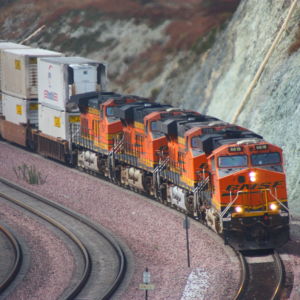One of these things is not like the others: Paid leave, child care, public housing investments, Civilian Climate Corps, fewer federal regulations on freight rail.
Give up?
Everything except reducing the regulatory burden on the nation’s freight railroads appears to be fair game for Democrats’ infrastructure bill.
For decades, federal infrastructure legislation has been one of Congress’s reliable bipartisan moments, with regional coalitions forming to support costly projects such as building new bridges or investing in highway repairs and upgrades. Roads and bridges are two of the most visible projects, but airports, rail lines, and water infrastructure were also part of the mix.
With full (albeit shaky) control of Congress and the White House, however, Democrats have been eyeing a purely partisan, multi-trillion-dollar package. Rep. Ro Khanna (D-Calif.), a member of the Congressional Progressive Caucus, tweeted, “Green transportation, Elder care, Child care, Water pipes & service lines and Veterans’ hospitals” should be considered infrastructure. Similarly, Sen. Kirsten Gillibrand (D-N.Y.) tweeted, “Paid leave is infrastructure. Child care is infrastructure. Caregiving is infrastructure.”
But none of that addresses the issues built into a bill that the House Committee on Transportation and Infrastructure and observers say will harm freight rail.
The INVEST Act would infuse $60 billion into rail, including tripling funding for Amtrak to $29 billion over five years, increased funding for the Consolidated Rail Infrastructure and Safety Improvements (CRISI) grant program for both passenger and freight rail projects, and boosting Amtrak’s union workforce.
“This is a partisan product filled with special interest policy riders and unnecessary operational requirements,” said Rep. Rick Crawford (R-Ark.) during an InsideSources infrastructure roundtable. “We have a bill that will stifle innovation, hurt jobs, and negatively impact rail fluidity and service, lead to a modal shift away from the rails and to a less environmentally friendly mode of transportation, furthering congesting our highways.”
Two components highlighted in a fact sheet from the Transportation Committee: Democrats are taking action against “long trains” that stretch for more than 7,500 feet and train crossings that are blocked for more than 10 minutes at a time, plus prohibiting the Department of Transportation from permitting rail transport of liquified natural gas until “extensive safety analysis” is done.
Crawford said the bill would set back the freight rail industry at least a decade.
“The freight rail industry met the demands of our nation during the pandemic by never closing and continually moving the goods we needed to preserve public health and sustain our families all while safeguarding health and safety of the rail workforce,” he said. “They did all this, I might add, without asking for any bailout money, which is a novel concept to many that will benefit from this bill.”
The American Society of Civil Engineers gave freight a grade of B in its 2021 Infrastructure Report Card, noting that “freight maintains a strong network largely through direct shipper fees — investing on average over $260,000 per mile — passenger rail requires government investment and has been plagued by a lack of federal support, leading to a current state of good repair backlog at $45.2 billion.”
The Association of American Railroads, which blasted the INVEST Act, said, “Freight railroads are extremely disappointed in the deeply partisan, backward-looking rail title of the bill,” said association president and CEO Ian Jefferies. “If enacted, this legislation would undermine the ongoing modernization of the rail industry through outdated operational restrictions and capacity constraints, weakening the industry’s ability to serve its customers and the economy.”
The association highlighted one of the most egregious regulations contained in the INVEST Act, railing against a mandate to require two-people crews “in perpetuity” regardless of any technology or safety modernizations that would render two people in a cab outdated. In an era when computers are sophisticated enough to land a jumbo jet, mandating multiple crew members merely drives up costs.
The association also pushed back against a one-size-fits-all approach to railroad crossings, stating “each of the nation’s 200,000-grade crossings is different. This proposed … solution will lead to unintended consequences, including network congestion and reductions in service.”
What’s more, the Biden administration’s hostility to oil and natural gas pipelines, combined with the provision to halt trains carrying liquified natural gas, will force tens of millions of gallons of fuel resources onto trucks. According to an EPA report, “Class I railway operations on average emit about 22 grams of CO2 per ton-mile compared to truck operations which emit approximately 65 grams per ton-mile.”
The ironic, unintended outcome could be infrastructure legislation that includes billions for “Green New Deal” projects, while simultaneously promoting a higher-carbon transportation outcome.

